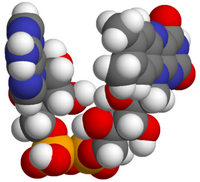
Photo from wikipedia
We report the first computational characterization of an optogenetic system composed of two photosensing BLUF (blue light sensor using flavin adenine dinucleotide) domains and two catalytic adenylyl cyclase (AC) domains.… Click to show full abstract
We report the first computational characterization of an optogenetic system composed of two photosensing BLUF (blue light sensor using flavin adenine dinucleotide) domains and two catalytic adenylyl cyclase (AC) domains. Conversion of adenosine triphosphate (ATP) to the reaction products, cyclic adenosine monophosphate (cAMP) and pyrophosphate (PPi), catalyzed by ACs initiated by excitation in photosensing domains has emerged in the focus of modern optogenetic applications because of the request in photoregulated enzymes that modulate cellular concentrations of signaling messengers. The photoactivated AC from the soil bacterium Beggiatoa sp. (bPAC) is an important model showing a considerable increase in the ATP to cAMP conversion rate in the catalytic domain after the illumination of the BLUF domain. The 1 μs classical molecular dynamics simulations reveal that the activation of the BLUF domain leading to tautomerization of Gln49 in the chromophore-binding pocket results in switching of the position of the side chain of Arg278 in the active site of AC. Allosteric signal transmission pathways between Gln49 from BLUF and Arg278 from AC were revealed by the dynamical network analysis. The Gibbs energy profiles of the ATP → cAMP + PPi reaction computed using QM(DFT(ωB97X-D3/6-31G**))/MM(CHARMM) molecular dynamics simulations for both Arg278 conformations in AC clarify the reaction mechanism. In the light-activated system, the corresponding arginine conformation stabilizes the pentacoordinated phosphorus of the α-phosphate group in the transition state, thus lowering the activation energy. Simulations of the bPAC system with the Tyr7Phe replacement in the BLUF demonstrate occurrence of both arginine conformations in an equal ratio, explaining the experimentally observed intermediate catalytic activity of the bPAC-Y7F variant as compared with the dark and light states of the wild-type bPAC.
Journal Title: Journal of chemical information and modeling
Year Published: 2021
Link to full text (if available)
Share on Social Media: Sign Up to like & get
recommendations!